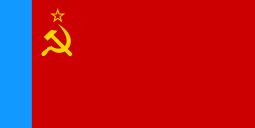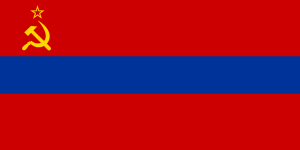Armenia–Russia relations
 |
|
Armenia |
Russia |
|---|---|

Armenia–Russia relations (Russian: Российско-армянские отношения, Armenian: Հայ-ռուսական հարաբերություններ) are the bilateral relationships between Armenia and the Russian Federation. Both countries are strategic allies and form an axis in the Caucasus along with Iran. Diplomatic relations between modern-day Armenia and Russia were established on April 3, 1992, but Russia has been an important actor in Armenia since the early 19th century. The two countries' historic relationship has its roots in the Russo-Persian War (1826-1828) between the Russian Empire and Qajar Persia after which Eastern Armenia was ceded to Russia. Moreover, Russia was often considered a protector of the Christian subjects of the Ottoman Empire, including the Armenians.[1]
After the dissolution of the Soviet Union, Armenia has been regarded as de facto the only ally of Russia in all of Transcaucasia. The positions of Russia and Armenia in the majority of key international problems are coincident or close. Armenia shares the approaches of Russia, directed toward strengthening of the CIS. Armenia and Russia are both members of a military alliance, the Collective Security Treaty Organization (CSTO), along with four other ex-Soviet countries, a relationship that Armenia finds essential to its security. Among the contracts and the agreements, which determine intergovernmental relations – a treaty of friendship, collaboration and mutual aid of 29 August 1997 are a number of the documents, which regulate bases of Russian military units and liaisons in the territory of Armenia.
History
The significant part of the territory currently belonging to Armenia was incorporated into the Russian Empire pursuant to the 1828 Treaty of Turkmenchay signed between Russia and Persia following the Russo-Persian War (1826–28).
After the 1917 Russian Revolution, Armenia gained short-lived independence as the First Republic of Armenia. By 1920, the state was incorporated into the Transcaucasian Socialist Federative Soviet Republic, a founding member of the Soviet Union that was formally constituted in 1922. In 1936, the Transcaucasian state was dissolved, leaving its constituent states, including the Armenian Soviet Socialist Republic, as full Union republics.
The modern Republic of Armenia became independent in 1991 as a consequence of the dissolution of the Soviet Union due to the failed coup that happened in August. Armenia boycotted the union-wide preservation vote earlier that year.
The Russian Federation, the successor state of the Soviet Union, is believed to have been instrumental in achieving victory by Armenians in the Nagorno-Karabakh War (1988–1994). In 2013, the deputy prime-minister of Azerbaijan Ali S. Hasanov said, "We need to become much stronger so that if we become involved in combat in Nagorno-Karabakh we can stand up to Russian troops, because that is who we will have to face. Did Armenia occupy our territories? Do you think Armenia's power is sufficient for that?”[2]
-

Flag of the Russian Soviet Federative Socialist Republic (1954–1991)
-

Flag of the Armenian Soviet Socialist Republic (1952–1990)
Developments since 2013
Faced with the choice of either joining the Russia-led Customs Union or signing the Association Agreement with the European Union, Armenia eventually chose the former option. The decision on Armenia's accession to the Customs Union was announced by the president of Armenia Serzh Sargsyan on 3 September 2013.[3][4]
On 2 December 2013, Russian president Vladimir Putin arrived to Armenia on an official visit. The heads of the two states discussed Armenia's accession to the Customs Union and signed 12 agreements on enhancing cooperation in a number of key spheres such as security, economy, energy and others. Russia also reduced the gas price for Armenia from 270 to 189 dollars per 1,000 cubic meters and enlarged the existing Russian military bases in Armenia.[5][6]
Armenia became a full member of the Eurasian Economic Union from January 2, 2015, whereupon cooperation and integration with Russia reached a new level.
Gyumri murders
On January 12, 2015 Valery Permyakov, a Russian soldier from the 102nd military base in Gyumri, murdered an Armenian family of seven during the night.[7] He was formally charged under Armenian Criminal Code but still held at the 102nd military base.[8]
On January 15, protests broke out in Gyumri demanding that Permyakov be handed over to the Armenian justice system. Due to police force, fourteen people were hospitalized after the clashes.[9] A protest was also held at Freedom Square within Yerevan where 20 people were detained due to clashes with police.[10] The protesters argue that taxpayers’ money is being used to pay for soldiers that kill Armenian citizens, rather than protect them. Russian authorities are likely concerned that the public trial of a Russian soldier in Armenia will deeply damage the reputation of Russia’s military worldwide, especially in light of developments in Euromaidan.[11]
Military union
Military cooperation between Armenia and Russia is based on both states being members of the military alliance as well as participants in the Joint CIS Air Defense System. United Russian–Armenian troop groups are formed. The border guards group of the Russian FSB in Armenia together with the Armenian frontier-guards provide the protection of the boundaries of the republic with Turkey and Iran.
In October 2013, the chief commander of Russia′s 102nd military base Andrey Ruzinsky said to Russia′s official military newspaper, "If Azerbaijan decides to restore jurisdiction over Nagorno-Karabakh by force the [Russian] military base may join in the armed conflict in accordance with the Russian Federation’s obligations within the framework of the Collective Security Treaty Organization."[12][13]
The 102nd Russian military base is stationed in Gyumri in the northwestern part of Armenia. The base was upgraded by a Russian-Armenian defense agreement signed in 2010. The agreement extended Russia’s basing rights in Armenia until 2044. Moscow also undertook to supply Armenia with more weapons and military hardware.[12] On 8 December 2015, the Erebuni base (part of 102nd) was reinforced with six advanced Mi-24P assault helicopters and an Mi-8MT transport helicopter delivered from the Russian Air Force base in the Krasnodar region.[14][15]
On 23 December 2015, Russian defence minister Sergei Shoygu and his Armenian counterpart, Seyran Ohanyan, signed an agreement to form a Joint Air Defense System in the Caucasus.[14][16] The conclusion of the agreement followed the Armenian minister′s assertion that the ceasefire with Azerbaijan over the breakaway region of Nagorno-Karabakh virtually no longer existed.[17] In June 2016, Armenia's National Assembly voted 102–8 to ratify an agreement to create an Armenia–Russia joint air defense system.[18]
In November 2016, Russian president Vladimir Putin approved a government proposal on creating joint Russian and Armenian military forces.[19] The two sides are to create a joint command, whose leader will be appointed by the Supreme Commander of the Armenian Armed Forces in agreement with the Supreme Commander of the Russian Armed Forces.[20]
See also
References
- ↑ LUIGI VILLARI. Fire and Sword in the Caucasus. p. 65.
the khanates of Erivan and Nakhitchevan were conquered in 1828— 29 after a last war with Persia ;
- ↑ "Azerbaijan says will face Russian soldiers in Karabakh in case of war". Today's Zaman. 1 March 2013. Retrieved 25 December 2015.
- ↑ "Armenia To Join Russian-Led Customs Union". RadioFreeEurope/RadioLiberty. Retrieved 15 April 2016.
- ↑ Helix Consulting LLC. "EU-Armenia: About decision to join the Customs Union". Retrieved 15 April 2016.
- ↑ "Россия и Армения подписали 12 документов в ходе визита Владимира Путина в Ереван". ИА REGNUM. Retrieved 15 April 2016.
- ↑ "Эхо Москвы :: Новости / Армения получила скидку на газ еще не подписав даже "дорожную карту" по вступлению в Таможенный союз". Эхо Москвы. Retrieved 15 April 2016.
- ↑ "Interfax. "Joint commission to coordinate Armenian-Russian inquiry into Gyumri murder." Interfax: Russia & CIS Military Newswire 20 Jan. 2015: 1. Regional Business News. Web. 11 Nov. 2016.".
- ↑ "Interfax. "Armenia's ruling party says case of Russian soldier suspected of Gyumri murder should not be politicized." Russia & FSU General News 16 Jan. 2015: 1. Regional Business News. Web. 11 Nov. 2016.".
- ↑ Interfax. "Joint commission to coordinate Armenian-Russian inquiry into Gyumri murder." Interfax: Russia & CIS Military Newswire 20 Jan. 2015: 1. Regional Business News. Web. 11 Nov. 2016.
- ↑ nterfax. "Armenia's ruling party says case of Russian soldier suspected of Gyumri murder should not be politicized." Russia & FSU General News 16 Jan. 2015: 1. Regional Business News. Web. 11 Nov. 2016.
- ↑ "Gyumri Murders Threaten to Disrupt Armenia's Relations with Russia". www.cacianalyst.org. Retrieved 2016-11-13.
- 1 2 "Russian Base In Armenia Signals Role In Possible Karabakh War". Radio Free Europe/Radio Liberty. 30 October 2013.
- ↑ "Южный форпост России". Krasnaya Zvezda. 10 October 2013.
- 1 2 Russia, Armenia unite air defenses, create regional system in the Caucasus RT, 23 December 2015.
- ↑ "Russian military helicopters stationed near Turkey". DW. 8 December 2013.
- ↑ "Russia, Armenia unify air defense systems in Caucasus". Hürriyet Daily News. 24 December 2015. Retrieved 25 December 2015.
- ↑ "Ankara: Russia-Armenia deal heats up Caucasus". Hürriyet Daily News. 25 December 2015. Retrieved 25 December 2015.
- ↑ "Armenia ratifies agreement on joint air-defense system with Russia". Reuters. June 30, 2016. Retrieved June 30, 2016.
- ↑ Распоряжение Президента Российской Федерации от 12.11.2016 № 359-рп "О подписании Соглашения между Российской Федерацией и Республикой Армения об Объединенной группировке войск (сил) Вооруженных Сил Республики Армения и Вооруженных Сил Российской Федерации"
- ↑ Russia and Armenia to Create Joint Military Forces The Moscow Times, 14 November 2016.
External links
| Wikimedia Commons has media related to Relations of Armenia and Russia. |

